Key takeaways
- A French photography portfolio emphasizes artistic vision and emotional storytelling, showcasing the photographer’s unique style and connection to cultural heritage.
- Photo editing is crucial for enhancing visual appeal and narrative impact, transforming raw images into compelling stories through technical adjustments.
- Collaboration with a photo editor fosters personal growth by encouraging open communication and constructive feedback, ultimately strengthening the portfolio’s emotional depth.
- Successful editing partnerships are built on clear communication, mutual trust, and a willingness to embrace feedback to elevate the artistic vision.
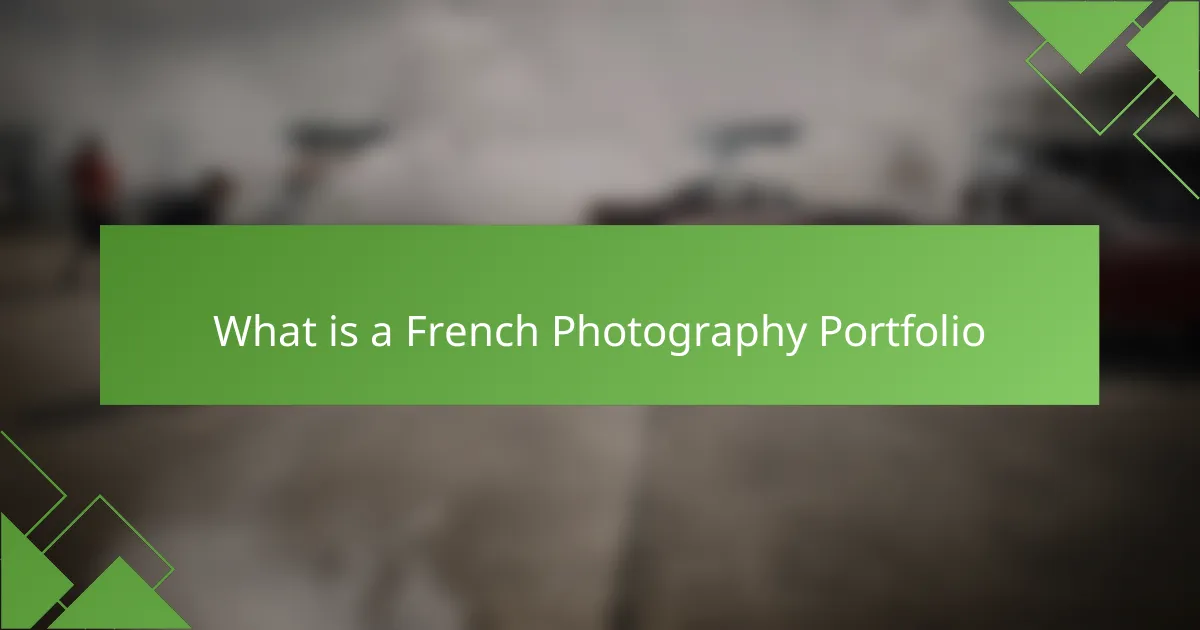
What is a French Photography Portfolio
A French photography portfolio showcases the artistic vision and unique style of a photographer, often reflecting the cultural richness and aesthetic values of France. In my experience, these portfolios blend technical skill with an emotional narrative, allowing viewers to connect with the photographer’s perspective consciously. I’ve often found that a well-curated portfolio tells a story, drawing the audience into the photographer’s world through captivating imagery and thoughtful composition.
Creating a French photography portfolio can be particularly special for photographers who want to highlight their connection to France’s artistic heritage, whether through scenic landscapes, vibrant street photography, or intimate portraiture. Working with a photo editor helped me choose images that best represent my experiences and emotions, making the portfolio feel like an authentic extension of my artistic journey.
| Aspect | French Photography Portfolio |
|---|---|
| Focus | Artistic vision and cultural context |
| Style | Emotionally-driven narratives |
| Purpose | Showcase personal style and stories |
| Typical Subjects | Landscapes, street scenes, portraits |
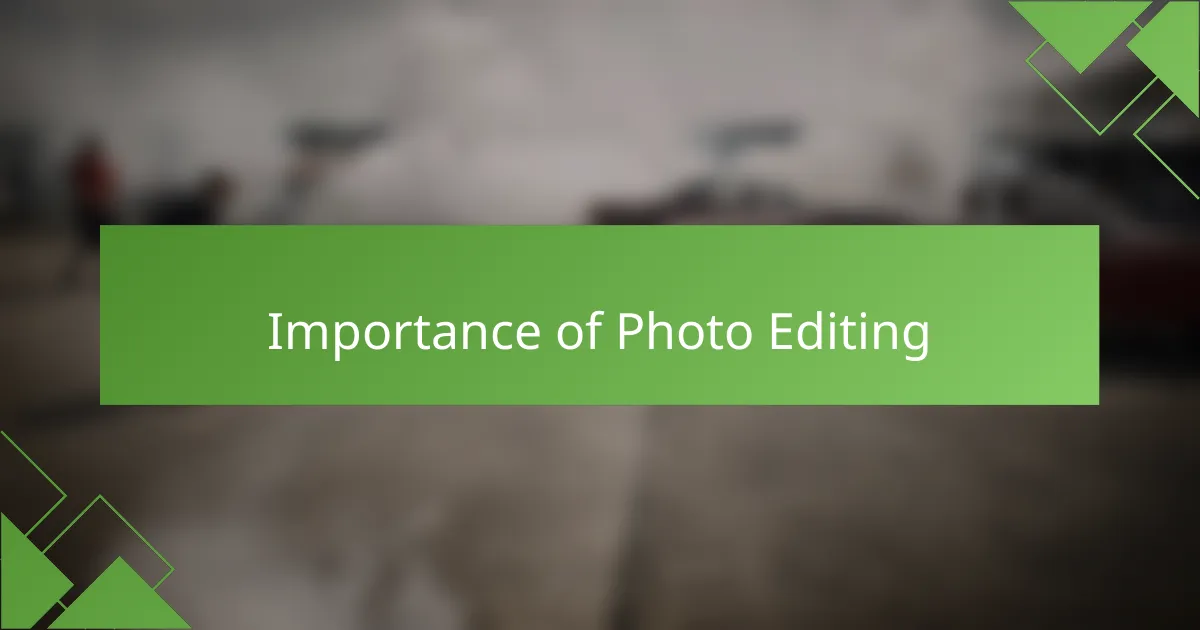
Importance of Photo Editing
Photo editing plays a crucial role in enhancing a photograph’s visual appeal. From correcting lighting to fine-tuning colors, these adjustments help convey the intended mood and message. I remember working on a project where the raw images were beautiful but lacked that polished edge. Once my photo editor worked their magic, the images truly came alive, evoking emotions I hadn’t anticipated.
Moreover, photo editing is not just about making things look good; it’s about storytelling. The right edits can highlight the essence of a moment by guiding the viewer’s eye to the focal point. During my collaboration, I realized how much of an impact small adjustments could have, transforming my portfolio into a compelling narrative of my experiences.
Here’s a comparison table highlighting the differences between raw images and edited images:
| Aspect | Raw Images | Edited Images |
|---|---|---|
| Color Correction | Often dull or unbalanced | Vibrant and harmonious |
| Lighting | May look flat or overexposed | Dynamic and engaging |
| Emotional Impact | Minimal | Powerful storytelling |
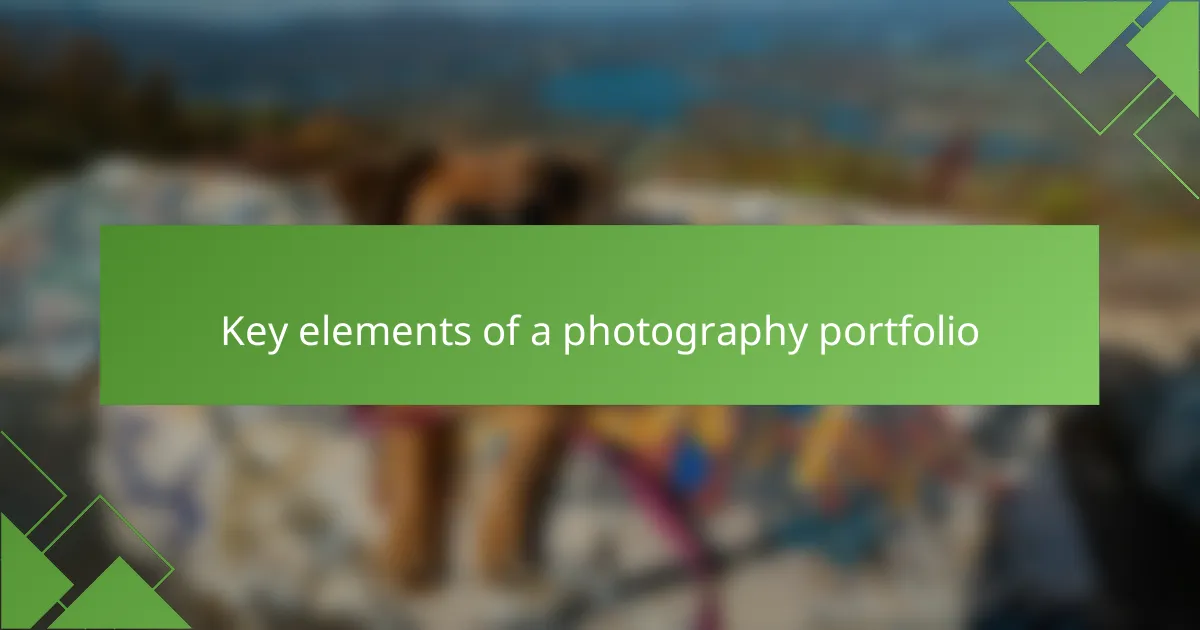
Key Elements of a Photography Portfolio
When I think about the key elements of a photography portfolio, I immediately recall my first collaboration with a photo editor. It was thrilling to see how their expertise transformed my raw images into a cohesive narrative. The choice of images, the sequencing, and even the editing style played a critical role in highlighting my vision.
One key element is the selection of work. Not every photograph deserves a spot in the portfolio. I learned that it’s important to showcase not only my best shots but also pieces that represent my personal style and artistic voice. Moreover, the organization of the portfolio can greatly influence a viewer’s experience, guiding them from one story to another, which is something my photo editor emphasized throughout our project.
Finally, presentation matters. Whether online or physical, how the portfolio is displayed can evoke different feelings. I remember the excitement of seeing my best works framed elegantly for a gallery show, which left a lasting impression on the viewers and me alike.
| Element | Description |
|---|---|
| Selection of Work | Showcase best images that reflect your unique style. |
| Organization | Sequence photos to create a cohesive narrative. |
| Presentation | Consider how the portfolio is displayed, enhancing viewer engagement. |
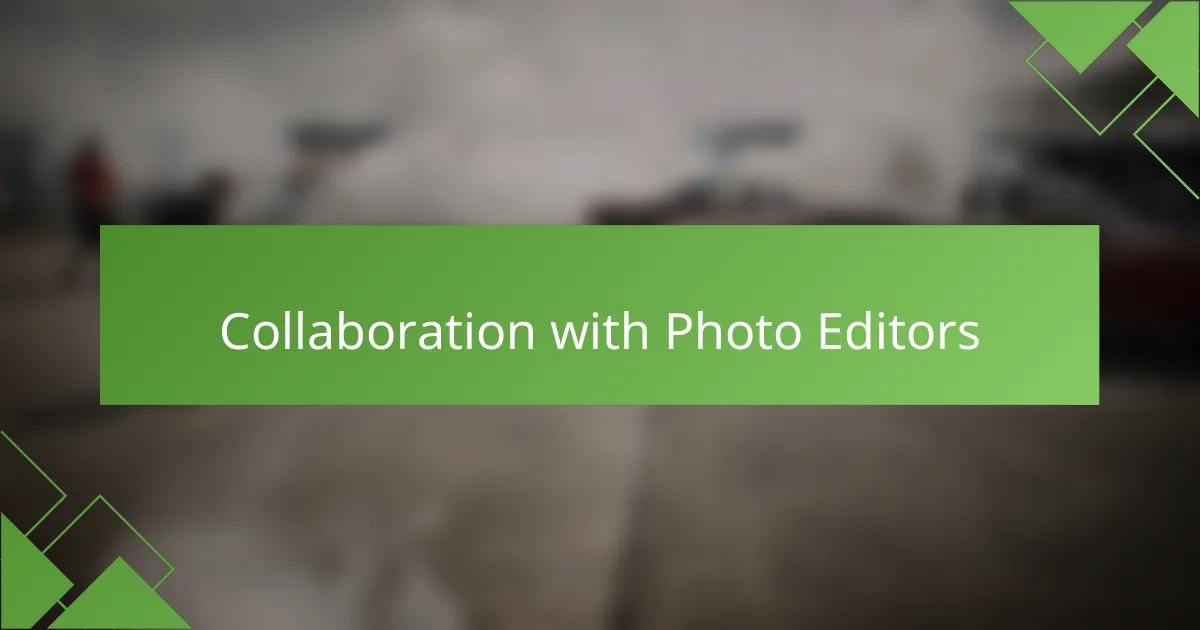
Collaboration with Photo Editors
Collaboration with a photo editor can be an illuminating experience. I still remember the first time I sat down with one; it felt like a light bulb flicking on. We dissected my images, discussing the emotions I hoped to evoke and recognizing the areas that could be enhanced. It was fascinating to see how their perspective brought new life to my work, highlighting aspects I hadn’t considered.
There’s something deeply rewarding about teamwork in this creative process. I once presented a series of landscapes that I thought showcased my journey, but my editor pointed out which photos lacked the emotional depth I intended. Together, we honed in on the images that told stories, reinforcing the connection between my artistic vision and the viewer’s experience. This partnership didn’t just elevate the technical aspects of my portfolio; it enriched the emotional narrative as well.
Trusting a photo editor with your work is a decision that forces you to confront your own creative insecurities. I found myself asking, “What does this image say about me?” As we collaborated, I discovered the importance of vulnerability in sharing your art. It’s through this delicate balance of collaboration and personal reflection that I was ultimately able to create a portfolio that genuinely felt like an extension of my identity.
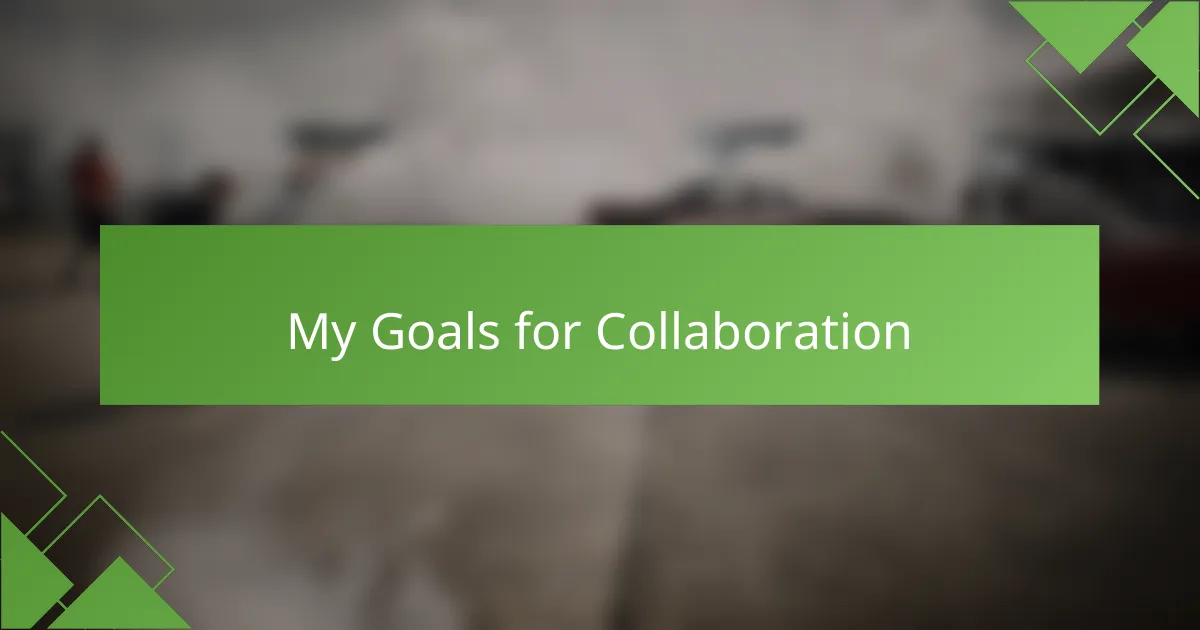
My Goals for Collaboration
When I embarked on my journey of collaborating with a photo editor, I had clear goals in mind. Most importantly, I aimed to enhance the storytelling aspect of my photography, ensuring that each image resonated emotionally with viewers. I wanted my photographs to not just capture moments but to evoke feelings and memories, much like how a well-written narrative can draw you in.
To achieve this, I focused on several key objectives:
- Strengthening Visual Narrative: I aimed to ensure that every photograph told a story.
- Refining Aesthetic Consistency: I wanted the final portfolio to have a cohesive look that represented my style.
- Expanding Technical Skills: Working with an editor provided an opportunity to learn new editing techniques and approaches.
- Elevating Professionalism: Collaborating with someone experienced helped me gain credibility in the industry.
Reflecting on these goals, I felt a mix of excitement and nervousness. The possibility of creating something greater than the sum of its parts was thrilling.
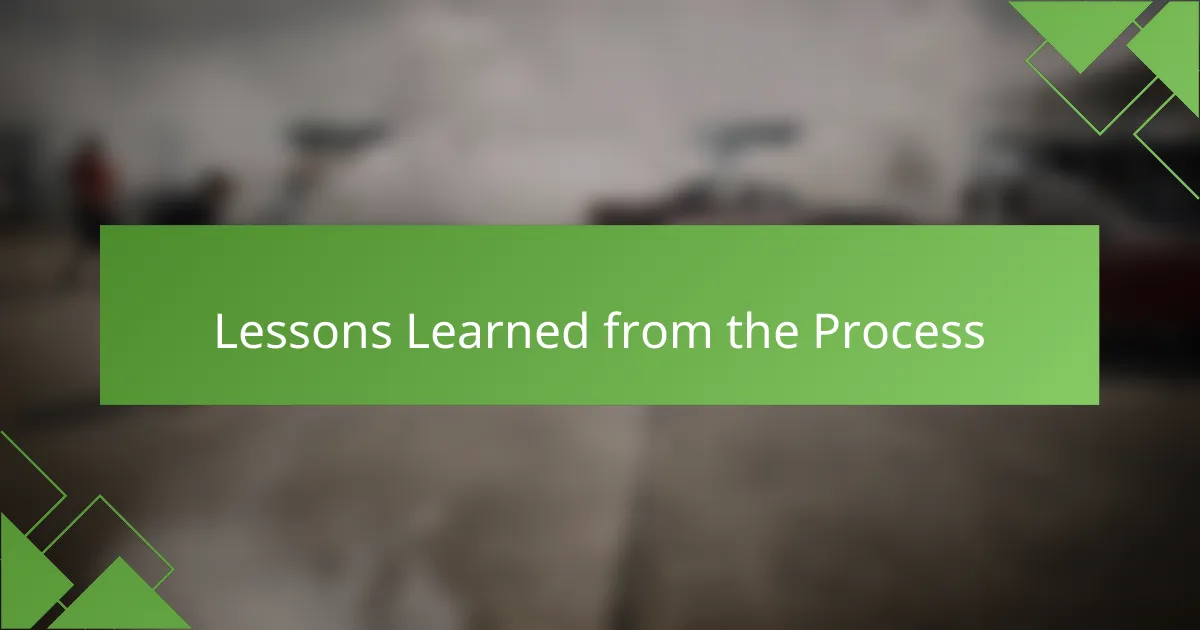
Lessons Learned from the Process
It’s amazing how much I learned about the power of communication during my collaboration with a photo editor. Initially, I thought the process would be just about choosing images and making tweaks, but it turned out to be a deep dive into sharing my artistic intent. I remember a moment when we reviewed one particular photo that I adored. My editor challenged my attachment to it, asking, “What story does this photo really tell?” That question pushed me to reflect on my own work in a way I hadn’t before.
Another key lesson was the importance of being open to feedback. At first, I felt protective over my photographs, but I soon realized that my editor’s insights were invaluable. For instance, they suggested enhancing the contrast on a landscape shot I had deemed perfect. I was initially hesitant, thinking it would ruin my vision, but when I saw the edited version, it transformed the image. This taught me that collaboration isn’t about losing control; it’s about evolving as an artist.
Ultimately, the collaboration highlighted the emotional depth that a well-edited portfolio can achieve. Each image, once raw and personal, became a vessel for storytelling. I found myself asking, “How do I want my audience to feel?” and that simple question made an enormous difference in how I curated my work. It was a journey that reinforced the idea that art thrives on connection – both with the artist and the viewer.
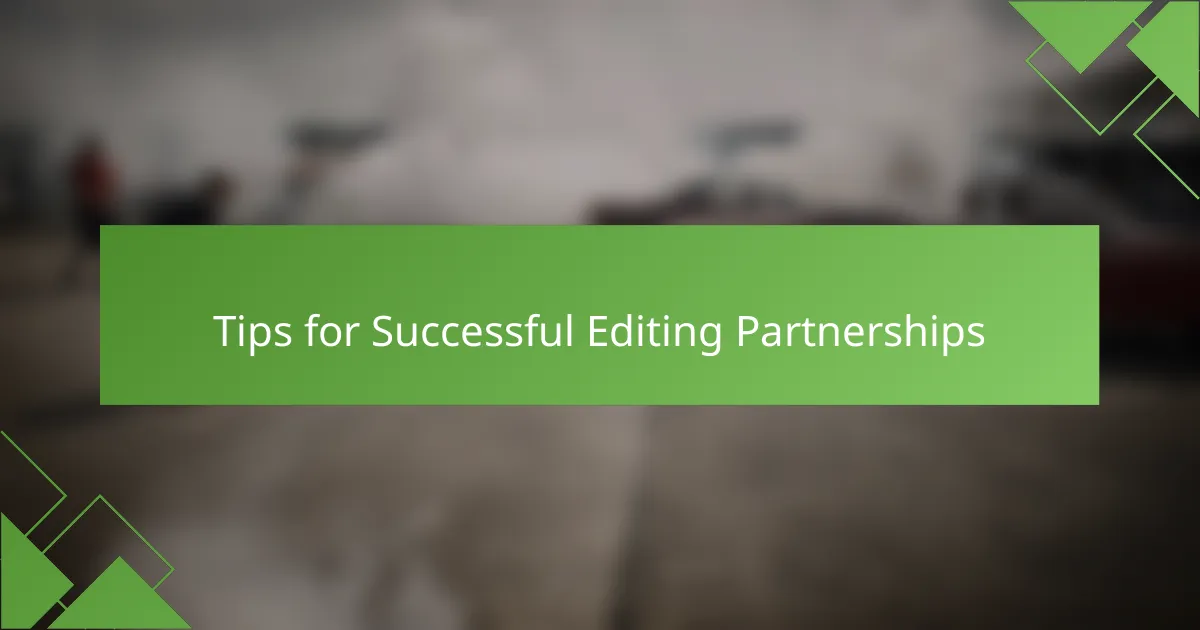
Tips for Successful Editing Partnerships
To build a successful editing partnership, clear communication is essential. I realized that sharing my artistic vision upfront creates a strong foundation for collaboration. For example, during my first meeting with the photo editor, I laid out my intentions and inspirations, which helped them understand the emotion I wanted each image to convey. Have you ever found it challenging to articulate your vision? I know I have, but being honest about my artistic goals made the editing process flow smoothly.
Another important tip is to embrace feedback with an open mind. I recall a moment when my editor suggested removing a photo I felt particularly attached to. At first, I resisted, thinking, “How can I let go of something I love?” But after reflecting on their reasoning, I understood that this choice would ultimately strengthen the overall narrative of my portfolio. Being open to constructive criticism can lead to growth and improved outcomes, even when it feels uncomfortable.
Lastly, establishing trust with your photo editor will enhance the partnership immensely. I found that building a relationship based on mutual respect and understanding allowed us to take creative risks together. Each editing session felt less like a review and more like an exploration of what my work could become. Trusting in their expertise reminded me that collaboration is a two-way street, enabling both parties to grow creatively and deliver a portfolio that genuinely represents my vision.